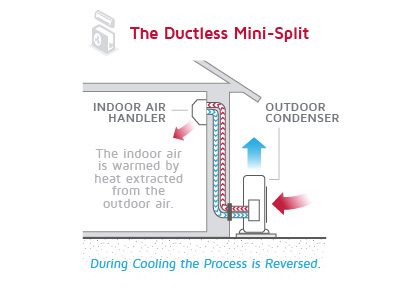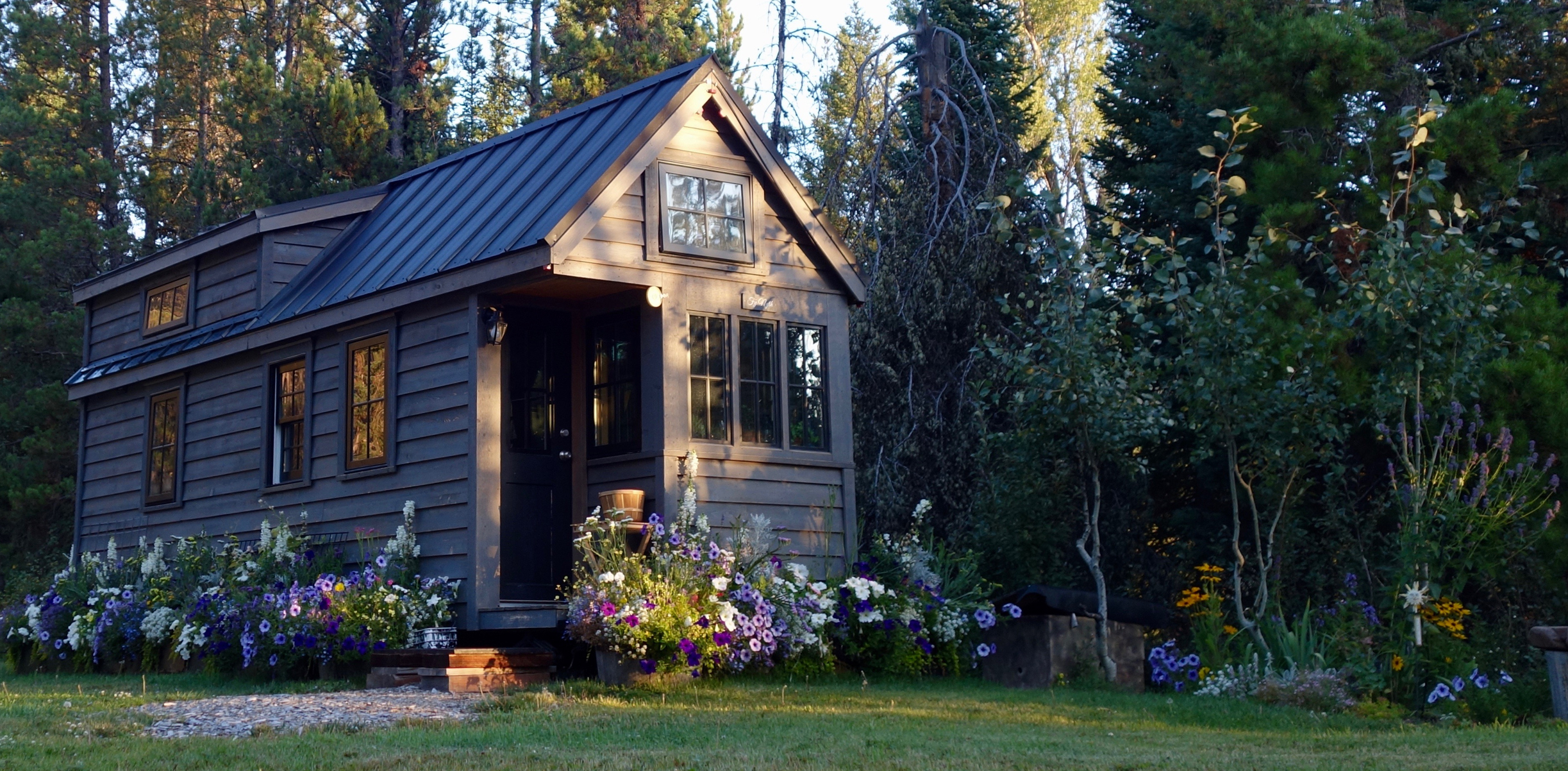Tiny homes have surged in popularity. In recent years, tiny homes have transitioned from a novelty to a practical living choice, appealing to various demographics for their sustainability, cost-efficiency, and versatility. While some owners make them their permanent dwelling, they are also commonly used for office space, vacation rentals, and guest housing.
While tiny homes have seen an increase in design options and available amenities, they’re still… well, tiny – typically under 500 square feet. Being this small comes with certain limitations and special requirements, including heating and cooling. In order to be comfortable year-round, these compact homes need flexible and efficient heating and cooling systems tailored to their unique constraints.
Understanding the Unique Challenges of Tiny Home Heating and Cooling
These days, tiny homes are found all around the world, including in areas where temperatures vary greatly season to season. Despite this, their size leaves little room for ductwork or the level of insulation typical of a standard home – so having an efficient and adaptable heating or cooling source is crucial.
Like a traditional home; location, size, budget, and heating and cooling preferences should be taken into account when determining the right HVAC solution for your tiny home. However, unlike a traditional home, tiny homeowners must also consider the specific design constraints of their home and whether it is mobile or stationary.
Though there are a variety of options that will work to heat and cool most tiny homes, many of them come with trade-offs related to efficiency and cost. While electric space heaters and window units are inexpensive options that may work for you, they can be inefficient and lead to increased energy usage over time. Similarly, options such as fireplaces and fans may not provide consistent heating and cooling and may not be reliable as primary sources. Let’s explore some of the more accessible options.
Heating and Cooling Options for Tiny Homes
There are many heating and cooling options suitable for most tiny homes, each with its own specific benefits and drawbacks.
Ductless Mini-Splits
Our recommendation, especially for stationary tiny homes is the mini-split system. These systems are much smaller than traditional HVAC units and do not require space-consuming ductwork. Instead, they consist of one or more indoor units and a singular outdoor unit, connected through refrigerant lines and electrical wires, allowing the air to move from the outdoor unit to the indoors. Most ductless mini-split systems generate hot and cold air, making them an optimal, space-saving choice for tiny homeowners, especially in climates that fluctuate throughout the year.
Ductless mini-split systems also offer the flexibility to create single or multiple heating and cooling zones within your home, allowing individual temperature control in each space. Tiny homeowners can choose to use a single indoor unit or have several installed, depending on the home's size and layout. The indoor units can be mounted on the floor, ceiling, or wall to maximize space, which is particularly important for tiny homes with loft bedrooms experiencing different temperatures than the space downstairs.

Portable Solutions
Space Heaters
Even in small spaces, you might find that certain spots are a bit colder than others. In these cases, a small space heater can effectively heat those specific areas. These heaters are often compact, affordable, and effective at heating small spaces, but they are not suitable for heating the entire tiny home and should not be relied on as a long-term solution.
Gas or Electric Fireplaces
Much like a space heater, gas or electric fireplaces can provide extra heat in your tiny home. While they may not be the primary heating source, they can add warmth to your home in the winter – and look great while they do it.
Wood Burning or Pellet Stoves
If you're concerned about power outages, having a wood-burning stove can be a great backup plan. It's a reliable way to stay warm using a traditional, environmentally friendly method.
Window Air Conditioner
Window air conditioners, similar to those used in small rooms or apartments, are also a reliable option for cooling your tiny house. They are cost-effective and efficient, but depending on the size of your tiny home, you may need multiple units to cool the entire space.
Alternative Solutions
If you’re located in a moderate or mild climate zone, oscillating fans or ceiling fans may be all you need to stay comfortable in the summer. Well-positioned fans can keep the air moving within your home creating a cooler, less humid environment.
Maximizing Energy Efficiency in Tiny Home Heating and Cooling
Tiny homes, especially those designed for mobile living, are built for space efficiency and mobility. Because of this, they often have inadequate insulation for certain climates and they can develop leaks as the structure moves and shifts during transit. Luckily, there are a few things you can do to improve the efficiency of your tiny home, both during construction and after.
Maximize Your Tiny Home’s Insulation
The small size of a tiny home means that most of the space is reserved for critical systems like electricity and water. Due to this, there is less space for insulation, which helps with temperature regulation and holding in the natural heat or coolness of the space. Because of this, even when effectively heating and cooling a tiny home, it can be tough to keep the warm or cool air contained. Over time, this can result in a highly inefficient heating and cooling system, leading to excessive energy consumption and hefty energy bills.
Improving the insulation of your tiny home can keep your HVAC unit from repeatedly cycling through its heating and cooling processes by slowing the loss of conditioned air from the home. Investing in good insulation when you purchase or build will make a big difference in your indoor temperature regulation, as well as save you money on your electric bills. Speak with your builder about your insulation options or consult a home insulation pro to determine the best solution for improving the insulation in your home.
Inspect Windows, Doors, and other Seals
As with traditional homes, windows, doors, and other seals throughout your tiny home can contribute to the loss of conditioned air. Finding and fixing any leaks in your window frames and door jambs will go a long way to helping maintain more consistent temperatures within your home. In addition, direct sunlight can contribute to warming your home – especially in more modern tiny home designs that include large areas of glass. Window coverings that reduce or eliminate the ambient light within your tiny home can help bring indoor temperatures down during the summer.
Utilizing Renewable Energy in Your Tiny Home
If your tiny home is on wheels, you may look into taking advantage of solar power for an off-grid heating and cooling solution. Renewable power sources like solar can reduce your carbon footprint and energy bills, and help you live more eco-friendly. They can be used to power your HVAC system, and potentially saving hundreds per year on your electric bill.
Add Skirting and Upgrade Your Windows
Trailered or raised tiny homes are known for cold winter floors due to wind blowing underneath them. This happens even if the floors are insulated. Adding skirts around the base of your home can prevent the wind from blowing against the bottom of your tiny home.
Improving window insulation with thermal windows can also improve the efficiency of a tiny home. A single pane window allows more energy to pass through compared to a two pane window. Upgrading to thermal windows, which have insulating gas sandwiched between two, or sometimes 3 panes of glass can deliver a significant improvement to your insulation.
Tips for Maintaining Optimal Temperature in Your Tiny Home
Tiny homeowners often rely on traditional methods of heating and cooling, such as portable space heaters or window unit air conditioners. While these options can offer relief from extreme temperatures, they struggle to regulate the temperature throughout the space, resulting in hot or cold spots. This can make it challenging for tiny homeowners to achieve and maintain a comfortable temperature due to poor air circulation.
Install a Smart Thermostat in Your Tiny Home
Smart thermostats can be used to ensure your system is running when needed and saving energy when not. Determine daytime and nighttime temperatures that you and your family can be comfortable with and set your thermostat’s timer to maintain that cycle. Keeping your space a consistent temperature is far more efficient than turning it on only when you get uncomfortable. This can overwork your system and raise your energy costs.
The Importance of Proper Ventilation
Your home may be tiny, but adequate air circulation and ventilation are still critical to effective and efficient heating and cooling. Without proper airflow, even small spaces can develop hot spots or cold zones. In a tiny home, these inconsistent temperatures are most common in loft areas and rooms physically separated by doors or walls. If your HVAC system doesn’t have direct airflow access to these areas, augment with fans to ensure conditioned air is reaching the entire space or add a space heater to rooms that are closed to the ventilated space in winter.
Choosing the Right Solution for Your Tiny Home
Tiny homes present unique challenges when considering heating and cooling solutions. All of the same factors that can affect HVAC efficiency and consistency within a traditional home are not only present in tiny homes, they’re multiplied due to the extremely small size of the space.
The tiny homeowner’s final choice for heating and cooling can depend heavily on not only size, location, and budget, but also the specific design of the home, its purpose, and its mobility.
When efficiency and consistency matter most, especially when located in an area with wide seasonal temperature fluctuations, we recommend looking into a ductless mini-split solution. For the tiny home space, a mini-splits is a strong mixture of efficiency, capability, and simplicity.
If you’re considering purchasing a tiny home or in search of a heating and cooling system for yours, we encourage you to reach out to a local Lennox pro. They can help you weigh the pros and cons of a variety of solutions and steer you in the right direction for your tiny home solution.

